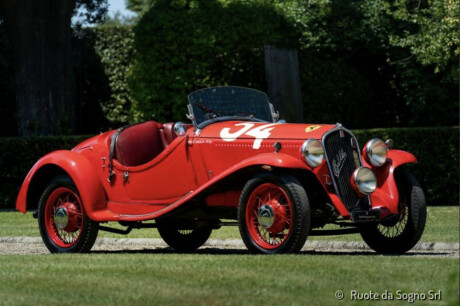
#SurrogateFuels
During the 1930s and 1940s, in a world marked by economic instability, military conflict, and protectionist policies, a range of so-called "surrogate fuels" emerged as practical and strategic alternatives to gasoline. Known in Italian as "carburanti succedanei," these fuels were developed to reduce dependence on imported petroleum, particularly in countries like Italy that lacked natural oil resources. The most widespread substitutes included gasogene (a wood- or coal-based gas produced on-board the vehicle through gasification), ethyl alcohol (ethanol) derived from the fermentation of agricultural products like sugar beets and cereals, and methyl alcohol (methanol), synthesized from wood or coal-based syngas. Methanol, in particular, proved especially effective in motorsport applications due to its high octane rating and cooler combustion, which allowed for higher compression ratios, improved performance, and reduced engine stress—especially in small-displacement engines. While technical and sporting motivations were significant, the adoption of surrogate fuels was also driven by economic and ideological imperatives. Gasoline was not only expensive and heavily taxed but also vulnerable to fluctuations in global supply, especially during wartime or under embargo. Surrogate fuels, often derived from domestic raw materials, provided a more stable and locally controllable source of energy. This aspect aligned closely with the Fascist regime's broader policy of economic autarky—a drive toward national self-sufficiency across all sectors, including energy. In this context, fueling vehicles with alcohol or gasogene became a political act, celebrated as a symbol of patriotic innovation and technological self-reliance. This ideological dimension was especially visible in the realm of competitive motorsport. In races such as the Mille Miglia, specific classes were created for vehicles running on surrogate fuels, with the dual aim of encouraging technical experimentation and promoting the regime’s propaganda message. The use of methanol in racing cars thus served both performance and political objectives: it allowed Italian machines to compete at high levels while embodying the Fascist ideal of independence from foreign influence. After World War II, the return of abundant, inexpensive petroleum—facilitated in part by the Marshall Plan—led to the gradual disappearance of surrogate fuels from everyday use. Yet their legacy remains a fascinating testament to a historical moment when technical ingenuity, economic necessity, and ideological ambition converged on the road and the racetrack alike.
We'll tell the story of this cars running on surrogate fuels on the occasion of their anniversary or when they will reach a sufficient number of cars.
If you would like to share your knowledge and archive, click on the banner JOIN THE LAB - HELP US TO IMPROVE & COMPLETE THE INFORMATION.
The census of all the cars related to this topic is in progress.
CARS (3)

1930 Alfa Romeo 6C 1750 Gran Sport
- Coachbuilder: Zagato
- Chassis n°: 8513048
- Engine n°: 6C 8513048
Private collection

1935 Alfa Romeo 6C 2300 Gran Turismo "Pescara" Spider
- Coachbuilder: Carrozzeria Touring
- Chassis n°: 6C 700635
- Engine n°: 6C 700635
Private collection

1935 Fiat 508 S Balilla Sport
- Coachbuilder: Carrozzerie Speciali Fiat
- Chassis n°: 508S*072038*
- Engine n°: 108CS-000347
Private collection